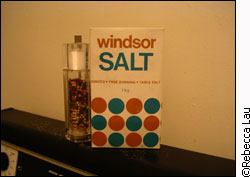
|
Illimar Altosar is a professor of biochemistry. He says Iodine Deficiency Disorder is the most common ailment in the world. His main research area is molecular bio-pharming, or the creation of genetically modified foods. Altosar also works with the International Food Policy Research Institute and the World Health Organization (WHO). Altosar says he's hopeful that one day his research will help to eliminate Iodine Deficiency Disorder. The CDC estimates that one billion people worldwide are effected by IDD. However, because the disorder is most common in underdeveloped countries and the effects can vary wildly from very mild to severe one billion is a conservative estimate. Iodine is a chemical element found on the periodic table. It is classified as a halogen and is required in trace amounts for most life forms to survive. According to the International Council for the Control of Iodine Deficiency Disorder, a non-profit, non-governmental organization connected to the WHO, the amount of iodine a person needs is quite small. In fact, they say that a person only needs to consume about one teaspoon full in a life time. The seemingly small requirement is often hard to ensure for two reasons. First, iodine does not stay in the body's system. The Council says people need to consume iodine in very small amounts continuously throughout their lives. The second problem is how to get iodine into the daily diets of people world wide. According to Altosar, much of what we eat doesn’t naturally contain iodine. This is because soil is not iodine rich. So, plants that take their nutrients from the soil also aren't iodine rich, in fact they contain so little iodine that they aren't enough to satisfy even the tiny daily amounts required. In turn, the animals that eat the plants don't get any iodine into their systems. So our fruits, vegetables and meat are not significant sources of iodine. The problem is at it's worst in mountainous regions because iodine levels in the soil are even further reduced by soil erosion due to wind and rain. Altosar says seafood, which is iodine rich, is the exeption.
The effects of Iodine Deficiency Disorder can vary widely. Iodine is essential to the performance of the thyroid and a deficiency can lead to cretinism, goiters, impaired cognitive function, impaired growth, infant mortality and stillbirths. Altorsar says, "it's the leading cause of mental retardation in the world." Although decreased mental ability is the most common effect of a deficient iodine intake level the other effects are also serious. According to Altosar pregnant women are most in need of proper amount of iodine. "If a woman doesn't have enough iodine in her system in the first two to three weeks of her pregnancy the baby will begin to lose mental ability," he says. Not only will can it be harmful to the baby, if a woman does not have enough iodine while pregnant it greatly increases the risk of miscarriages and stillbirths. The disorder typically effects children under 12, and babies still in the womb. After a child's mental development is complete, however, iodine deficiency disorder still occurs, but the greatest risk becomes acquiring a goiter.
Altosar says the reason most people in North America have never heard of Iodine Deficiency Disorder is because almost all commercial salt has been iodized since the 1920s. Iodized salt is a cheap and effective way of guarding against the problems associated with Iodine Deficiency Disorder. Altosar explains it's not foolproof. "Iodine is extremely volatile, if it’s left out it will begin to dissipate," he says. In North America people consume enough salt that the dissipation isn't a concern. However, in India, Southeast Asia and central Africa where iodine deficiency is a major problem, iodized salt isn't always a feasible solution. The normal diet doesn’t contain near as much salt as that in the West, and transporting iodized salt is difficult while trying to maintain iodine levels. Engineering iodine into food Altosar says the answer can be found in his favourite saying, "food is the first medicine." He says that the way to cure Iodine Deficiency Disorder is to put more iodine into the foods people already eat.
In conjunction with the International Food Policy Research Institute and the WHO, Altosar is researching the effects of putting human thyroid gland proteins into plants, specifically maize, casaba, potatoes and rice. He says that the proteins help the plants take in more iodine, ultimately making them a better source of iodine for humans. The human genetic material is placed into the plants by a process called Agrobacterium-mediated transformation. The process involves taking a string of plant DNA, called a plasmid, that would normally cause a tumor to grow in plant cells it encountered, and replacing the malignant material with the human protein natrium-iodine symporter (NIS). Then, when the tumor causing plasmid is put in a plant, rather than making a tumor grow in the cells, it makes NIS grow. This helps the plants because it then has more iodine seeking proteins. Proteins are used by cells to gather specific nutrients, chemicals and other compounds the cell needs to survive. Each protein is programmed to gather a certain compound, be it a nutrient or chemical. The more proteins a cell has dedicated to gathering iodine, for instance, the more it will get. NIS is an iodine gathering protein. By giving the crops additional iodine gathering proteins they have been able to increase the iodine uptake of the plants, making them a better source of iodine for the people who eat them. Altosar says he hopes eventually this research will be passed on to the people affected by Iodine Deficiency Disorder in the form of genetically modified seeds. The seeds will then grow into iodine rich crops. Iodine Deficiency Disorder is completely preventable. Altosar says he hopes that one day it will be eradicated by improving the quality of the foods people around the world eat.
|
|
|


